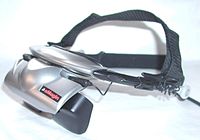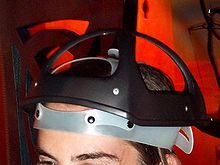Head-mounted display: Difference between revisions
| Line 72: | Line 72: | ||
* [[Takara]] DYNOVISOR HMD |
* [[Takara]] DYNOVISOR HMD |
||
* [[TDVision]]. |
* [[TDVision]]. |
||
* [http://www.vuzix.com Vuzix] |
|||
== Human measurements == |
== Human measurements == |
||
Revision as of 19:51, 13 May 2010
| Template:Wikify is deprecated. Please use a more specific cleanup template as listed in the documentation. |

A head-mounted display or Helmet mounted display, both abbreviated 'HMD', is a display device, worn on the head or as part of a helmet, that has a small display optic in front of one (monocular HMD) or each eye (binocular HMD).
Overview
A typical HMD has either one or two small displays with lenses and semi-transparent mirrors embedded in a helmet, eye-glasses (also known as data glasses) or visor. The display units are miniaturised and may include CRT, LCDs, Liquid crystal on silicon (LCos), or OLED. Some vendors employ multiple micro-displays to increase total resolution and field of view.
Types
HMDs differ in whether they can display just a computer generated image (CGI), show live images from the real world or a combination of both.
- Most HMDs display only a computer-generated image, sometimes referred to as a virtual image
- Some HMDs allow superimposing a CGI upon a real-world view. This is sometimes referred to as augmented reality or mixed reality. Combining real-world view with CGI can be done by projecting the CGI through a partially reflective mirror and viewing the real world directly. This method is often called Optical See-Through. Combining real-world view with CGI can also be done electronically by accepting video from a camera and mixing it electronically with CGI. This method is often called Video See-Through.
Applications
Major HMD applications include military, governmental (fire, police, etc.) and civilian/commercial (medicine, video gaming, sports, etc.).
Aviation
Ruggedized HMDs are increasingly being integrated into the cockpits of modern helicopters and fighter aircraft. These are usually fully integrated with the pilot's flying helmet and may include protective visors, night vision devices and displays of other symbology.
Tactical / ground
Military, police and firefighters use HMDs to display tactical information such as maps or thermal imaging data while viewing the real scene. Recent applications have included the use of HMD for paratroopers [1].
In 2005, the Liteye HMD was introduced for ground combat troops as a rugged, waterproof lightweight display that clips into a standard US PVS-14 military helmet mount. The self-contained color monocular OLED display replaces the NVG tube and connects to a mobile computing device. The LE has see-through capability and can be used as a standard HMD or for augmented reality applications. The design is optimized to provide high definition data under all lighting conditions, in covered or see-through modes of operation. The LE has a low power consumption, operating on four AA batteries for 35 hours or receiving power via standard USB connection. [2].
Engineering, science and medicine
Engineers and scientists use HMDs to provide stereoscopic views of CAD schematics. These systems are also used in the maintenance of complex systems, as they can give a technician what is effectively "x-ray vision" by combining computer graphics such as system diagrams and imagery with the technician's natural vision. There are also applications in surgery, wherein a combination of radiographic data (CAT scans and MRI imaging) is combined with the surgeon's natural view of the operation.
Gaming

Low cost HMD devices are available for use with 3D games and entertainment applications.
One of the pioneers in this field was Sony who released the Glasstron in 1997, which had as an optional accessory a positional sensor which permitted the user to view the surroundings, with the perspective moving as the head moved, providing a deep sense of immersion.
One novel application of this technology was in the game MechWarrior 2, which permitted users of the Sony Glasstron to adopt a new visual perspective from inside the cockpit of the craft, using their own eyes as visual and seeing the battlefield through their craft's own cockpit.
Sports
A HMD system has been developed for Formula One drivers by Kopin Corp. and the BMW Group. According to BMW, “The HMD is part of an advanced telemetry system approved for installation by the Formula One racing committee… to communicate to the driver wirelessly from the heart of the race pit.”
The HMD will display race crew critical race data while allowing the driver to continuing to focus on the track. Pit crews control the data and messages sent to their drivers through two-way radio.[3]
Performance parameters
- Stereoscopic imagery. A binocular HMD has the potential to display a different image to each eye. This can be used to show stereoscopic images. It should be heeded that so-called 'Optical Infinity' is generally taken by flight surgeons and display experts as about 9 metres. This is the distance at which, with the average human eye rangefinder "baseline" (distance between the eyes or Inter-Pupillary Distance (IPD)) of between 2.5 and 3 inches (6 and 8 cm), the angle of an object at that distance, becomes essentially the same from each eye. At smaller ranges the perspective from each eye is significantly different and the expense of generating two different visual channels through the Computer-Generated Imagery (CGI) system, becomes worthwhile.
- Field of view (FOV) – Humans have around 180° FOV, but most HMDs offer considerably less than this. Typically, greater field of view results in greater sense of immersion and better situational awareness. Most people do not have a good feel for what a particular quoted FOV would look like (e.g. 25°) so often manufacturers will quote an apparent screen size. Most people sit about 60 cm away from their monitors and have quite a good feel about screen sizes at that distance. To convert the manufacturer's apparent screen size to a desktop monitor position, just divide the screen size by the distance in feet, then multiply by 2.
- Resolution – HMDs usually mention either the total number of pixels or the number of pixels per degree. Listing the total number of pixels (e.g. 1600×1200 pixels per eye) is borrowed from how the specifications of computer monitors are presented. However, the pixel density, usually specified in pixels per degree or in arcminutes per pixel, is also used to determine visual acuity. 60 pixels/° (1 arcmin/pixel) is usually referred to as eye limiting resolution, above which increased resolution is not noticed by people with normal vision. HMDs typically offer 10 to 20 pixels/°, though advances in micro-displays help increase this number.
- Binocular overlap - measures the area that is common to both eyes. Binocular overlap is the basis for the sense of depth and stereo, allowing humans to sense which objects are near and which objects are far. Humans have a binocular overlap of about 100° (50° to the left of the nose and 50° to the right). The larger the binocular overlap offered by an HMD, the greater the sense of stereo. Overlap is sometimes specified in degrees (e.g. 74°) or in percent indicating how much of the visual field of each eye is common to the other eye.
- Distant focus ('Collimation'). Optical techniques may be used to present the images at a distant focus, which seems to improve the realism of images that in the real world would be at a distance.
- Inter-Pupillary Distance (IPD). This is the distance between the two eyes, measured at the pupils, and is important in designing Head-Mounted Displays.
Peripherals
- The most rudimentary HMDs simply project an image or symbology on a wearer’s visor or reticle. The image is not slaved to the real world (i.e., the image does not change based on the wearer’s head position).
- More sophisticated HMDs incorporate a positioning system that tracks the wearer’s head position and angle, so that the picture or symbology displayed is congruent with the outside world using see-through imagery.
- Head tracking – Slaving the imagery. Head-mounted displays may also be used with tracking sensors that allow changes of angle and orientation to be recorded. When such data is available in the system computer, it can be used to generate the appropriate computer-generated imagery (CGI) for the angle-of-look at the particular time. This allows the user to "look around" a virtual reality environment simply by moving the head without the need for a separate controller to change the angle of the imagery. In radio-based systems (compared to wires), the wearer may move about within the tracking limits of the system.
- Eye tracking – Eye trackers measure the point of gaze, allowing a computer to sense where the user is looking. This information is useful in a variety of contexts such as user interface navigation : by sensing the user's gaze, a computer can change the information displayed on a screen, bring additional details into attention, etc.
HMD manufacturers (alphabetically)
Companies that have produced HMDs include:
- Canon
- Cybermind
- EMagin (EMAN)
- Headplay
- The Link simulation division of L-3 Communications
- LASTER Technologies
- MyVu (formerly MicroOptical)
- Nintendo (Created the Virtual Boy video game platform)
- Olympus
- Rockwell Collins Optronics (formerly Kaiser Electro-Optics). Note that SEOS, previously an independent company but not part of Rockwell Collins, produced HMDs in the UK.
- Sensics
- Sony in Japan
- Takara DYNOVISOR HMD
- TDVision.
- Vuzix
Human measurements
The 95 percentile adult male in the USA has an Inter-Pupillary Distance (IPD) of 70 mm (2.8 in) and the 5 percentile, 58 mm (2.3 in). For adult females in the USA the figures are 65 and 53 mm (2.6 and 2.1 in). For Europeans the figures are 1 mm smaller[citation required].
- Anthropometry. Inter-Pupillary Distance (IPD) is one of the many measurements used in anthropometry, measurements of the human body. The statistical spread of these measurements, usually expressed as percentiles, is used for many purposes such as designing the size of airline seating and clothing sizes. In the case of IPD, it is used in specifying the size range not only for Head-Mounted Display systems but also for eyeglasses (spectacles), binoculars and other optics.
See also
- Helmet mounted display
- Augmented reality (AR)
- Computer-mediated reality
- Mixed reality (MR)
- Eyetap
- Stereoscopy
- Virtual reality (VR)
- Virtual retinal display
- Head-up display (HUD)
- Positioning technologies
Commercial products
- Virtual Boy, a video game platform with an HMD
- Sensics a commercial HMD with wide field of view and high resolution
- Shimadzu Data Glass 3/A, a 800x600 resolution commercial monocular HMD
- Glasstron The Sony Glasstron was a portable head-mounted display
- MyVu Low-resolution lightweight lower-priced commercial HMD
References
- ^ A Three Dimensional Helmet Mounted Primary Flight Reference for Paratroopers
- ^ www.defense-update.com/.../l/liteye-displays.htm
- ^ http://www.sid.org/news/archive/industrynews0210.html
